We would like to thank Hair Transplant Surgeon, Dr Greg Williams from the Farjo Hair Institute for his expert medical help in compiling this information.
The ARTAS Robotic Hair Restoration System is manufactured by Restoration Robotics and has been continually developed since 2005. It was first launched into the UK in February 2013, with the first installation into a West London clinic in September the same year. It is used to automate the hair transplant surgery process and is available in a select number of UK clinics and worldwide.
ARTAS claims to be the first, and still the only, robotic device for hair transplantation.
The primary function of the ARTAS robot had been to harvest hair follicular units, which are the naturally occurring groupings of hairs containing 1- 4 follicles. When a follicular unit is transplanted it is referred to as a graft. The typical donor area is the sides or back of the head, (FUE donor hair can also be taken from the beard and chest but not using the Artas robot). Software is now available to make recipient site incisions, and more recently, for automated implanting of grafts manually loaded into a canister, as a one-step procedure.
The donor areas contain hair follicles that are not sensitive to the male hormone dihydrotestosterone which causes the hair follicles on the front, top and crown areas of the head to miniaturise and become dormant, lead to balding – known as Male Pattern Hair Loss (MPHL).
These non-sensitive hair follicles will continue to produce hair throughout life. Lifelong hair follicles are present in good supply in most people and if they are transplanted successfully they continue to grow hair in the recipient area.
The ARTAS robot is a computerised device, which is controlled by the physician, and uses a three-dimensional optical system to isolate follicular units for maximum preservation of follicles in a FUE (Follicular Unit Excision) hair transplant procedure. This automation means that it is often referred to as Robotic Follicular Unit Excision (R-FUE), Robot-Assisted FUE or Robotic FUE. This minimally invasive solution utilises sophisticated digital mapping and precision robotics.
Once the follicles unit is identified, the skin around each follicular unit is incised using a punch device. The robot aids in the skin incision around the grafts with precision and speed that is said to surpass manual (human) techniques performed in most clinics. However, there are still many hair transplant surgeons who will be able to make the incisions faster than the robot.
ARTAS also claims to eliminate practitioner fatigue.
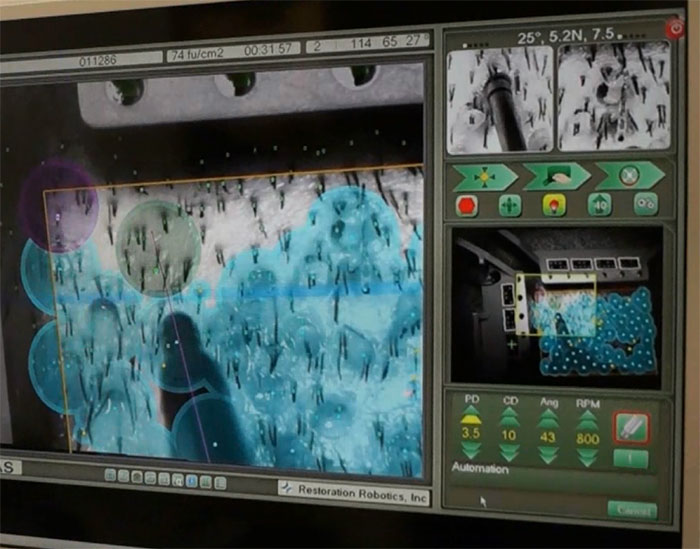
Image provided courtesy of Farjo Hair Institute
After an initial consultation with your hair transplant doctor, you will be able to agree on the area to be treated and the aesthetics of your hair transplant, such as the shape and position of your hair line. This should only follow discussion about your suitability for treatment, long-term expectations and likely results.
During your treatment, your head will usually be shaved, and the robotic optical system will be directed to the back and sides of your scalp to harvest healthy hair follicles. The spacing intervals between incisions must be selected by the doctor to ensure that plenty of healthy hairs are left in place, so the donor site hair density continues to look normal. The manually extracted follicles are then checked under the microscope by trained hair transplant surgical assistants for transections to ensure quality control. Using the robot to make incisions is also advocated to avoid damaging any healthy hair follicles in that area. The incision parameters can be set to ensure that the orientation of hair growth is natural and appropriate in terms of angle, direction and density.
During any FUE harvesting technique, manual, automated or robotic, there is a risk of hair wastage due to damage which is referred to as hair transection. A study in 2014, published in the Journal Dermatologic Surgery* measured follicular unit transection using the R-FUE procedure with the ARTAS system. The study found that robotic transection rates compared favourably with non-robotic FUE transection rates. The researchers found that the average transection rate over many R-FUE procedures was 6.6%. This rate compared to an average manual FUE transection rate of 6.14% which was reported in another study in 2006.

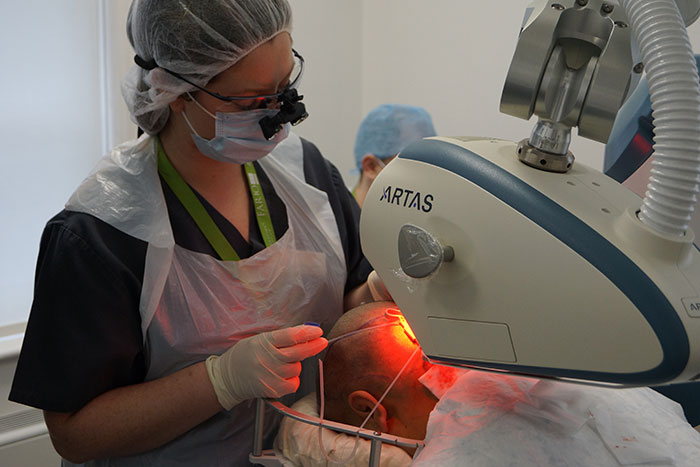
Images provided courtesy of Farjo Hair Institute
European CE Mark - approved in July 2012.
U.S. FDA (Food & Drug Administration) – approved in April 2011.
Hair restoration surgery of any kind should only be performed by trained and experienced medical doctors, who are registered and licensed on the General Medical Council. The surgery should only be carried out at a Care Quality Commission registered clinic in England or in a Healthcare Improvement Scotland registered clinic in Scotland, as appropriate, depending on the location.
For more information about practitioner training, qualifications and relevant medical organisations please view the information contained within the Legislation section of the Consulting Room.
Hair loss of the scalp, typically male or female pattern hair loss, but also in those who have sustained scars to the scalp through burns, trauma, surgery or radiotherapy.
ARTAS is only licensed to treat hair loss in those people with dark hair as the optical recognition system needs a good colour contrast to work correctly, but light hair can be dyed to allow follicle recognition.
Because the donated hair follicles are genetically resistant to hormone induced balding they should be a durable solution to hair loss. However, the long-term outcome varies from person to person and the prognosis needs to be discussed in the initial and subsequent consultations.
A local anaesthetic injection of lignocaine will be applied to the scalp (donor and recipient sites) during the procedure to minimise pain and discomfort. You may also be given a mild sedative. It is common after a hair transplant to have a tight, achy and swollen scalp for a few days and to experience temporary scabbing where the hair was transplanted.
On completion, you will just see many small, dot-like scabs in an irregular pattern in the donor area where hair was selectively harvested, rather than a line scar as is common with a surgical Strip FUT (Strip Follicular Unit Transplantation) procedure which removes an ellipse of scalp for the donor hairs. You may not be required to wear bandages or dressings.
A hair transplantation is generally considered to be a safe procedure, but there is always a small risk of excessive bleeding, infection or an allergic reaction to the anaesthetic. Your hair transplant surgeon should be able to treat these problems if they occur and will advise you on aftercare.
You should be very careful with your transplanted hair for the first 14 days after the operation, the newly transplanted grafts will not be secure in their new position initially.
Every hair transplant surgeon will have their own post-operative instructions which should be followed.
In general, you should be able to gently wash your hair immediately.
After 14 days, you should be able return to your normal hair care routine.
After a few weeks, the transplanted hair will often fall out, which can be quite disconcerting, but it will start to grow back again after a few months.
After six months, the results will start to become apparent.
After 12-18 months, the full results should be seen once the hair follicles have returned to their normal hair growth cycle.
People with any skin diseases or infections in the area to be treated should be counselled on additional risk or contra-indication to surgery. Patients with bleeding disorders or on blood thinners need special preparation, and those who need endocarditis prophylaxes should be identified. Generally, however, there are very few medical reasons why most healthy people should not undergo this hair restoration treatment but diabetics with hypertension who smoke constitute a high-risk patient population for wound healing problems and skin necrosis.
Pregnant and lactating women would be advised to wait before having a hair transplant, until hormone levels return to normal as changes in hair volume including significant postpartum and post-lactation shedding can occur.
The time taken for a treatment session will depend upon the number of grafts required, but a typical case of up to 2,000 grafts would likely take up to 8 hours.
The minimum number of grafts to make the use of the ARTAS robot justifiable (and cost effective) in a clinic depends on the costing model used by the clinic with some clinics opting only to use the ARTAS for cases over 1,200-1,500 FUE grafts.
The cost of treatment depends on many clinic-dependent factors but primarily on the number of grafts required. It is important that patients are clear on whether they are being charged per follicle (hair) or follicular unit (graft).
Prices for an ARTAS FUE hair restoration procedure will typically range between £5,000 and £10,000.
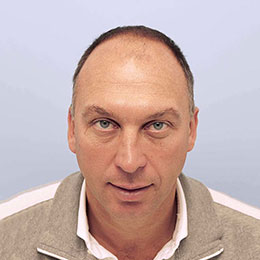
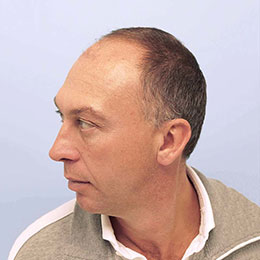

Hair loss before ARTAS treatment

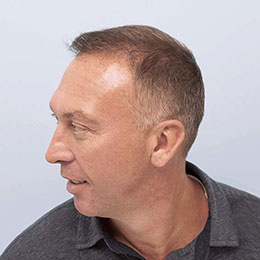
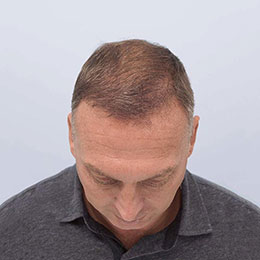
After 2,260 follicular unit grafts treated using the ARTAS system
Images provided courtesy of Farjo Hair Institute
(All before and after photographs are real patients, your results may differ).
Dermatol Surg. 2006;32:56–612.
New methodology and instrumentation for follicular unit extraction: lower follicle transection rates and expanded patient candidacy.
Harris JA.
Dermatol Surg. 2008;34:1683–8.
Novel technique of follicular unit extraction hair transplantation with a powered punching device.
Onda M, Igawa HH, Inoue K, Tanino R.
Med Image Comput Comput Assist Interv. 2011;14(Pt 1):113-20.
Robotic hair harvesting system: a new proposal.
Lin X, Nakazawa T, Yasuda R, Kobayashi E, Sakuma I, Liao H.
Dermatol Online J. 2014 Apr 16;20(4):22341.
Follicular unit extraction with the Artas robotic hair transplant system system: an evaluation of FUE yield.
Rashid RM.
Skinmed. 2014 Jul-Aug;12(4):213-6.
Surgical hair restoration and the advent of a robotic-assisted extraction device.
Gupta AK, Lyons DC, Daigle D, Harris JA.
* Dermatol Surg. 2014 Dec;40(12):1319-27
Robotic follicular unit extraction in hair transplantation.
Avram MR, Watkins SA.
J Am Acad Dermatol. 2015 Jan;72(1):146-50.
Characteristics of robotically harvested hair follicles in Koreans.
Shin JW, Kwon SH, Kim SA, Kim JY, Na JI, Park KC, Huh CH.
Dermatol Surg. 2015;41:279.
Commentary on Robotic Follicular Unit Extraction in Hair Transplantation.
Bernstein RM.
Dermatol Surg. 2016 Jun;42(6):710-4.
Robotic Follicular Unit Graft Selection.
Bernstein RM, Wolfeld MB.
Do you have a question? Ask one of our experts NOW